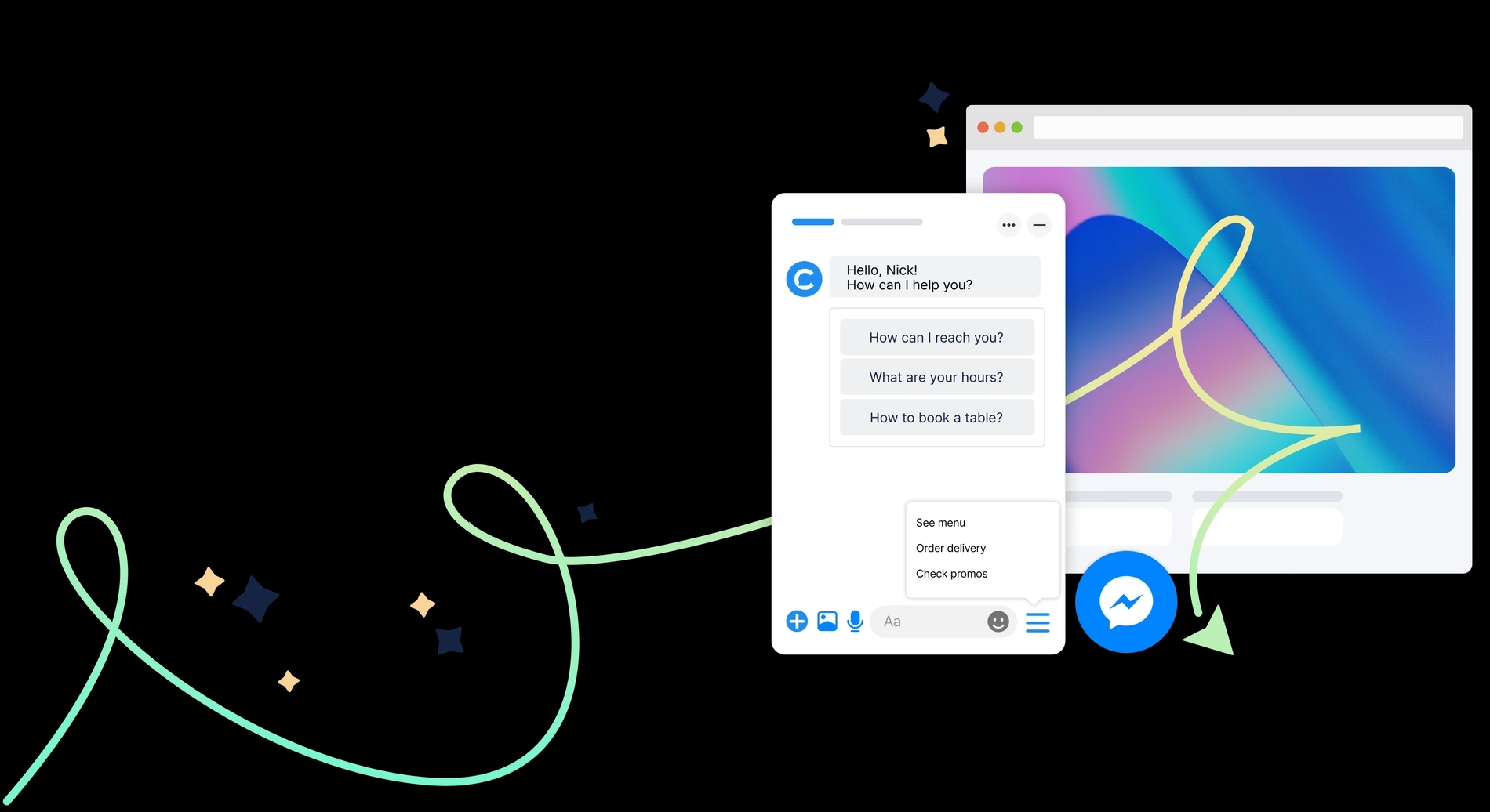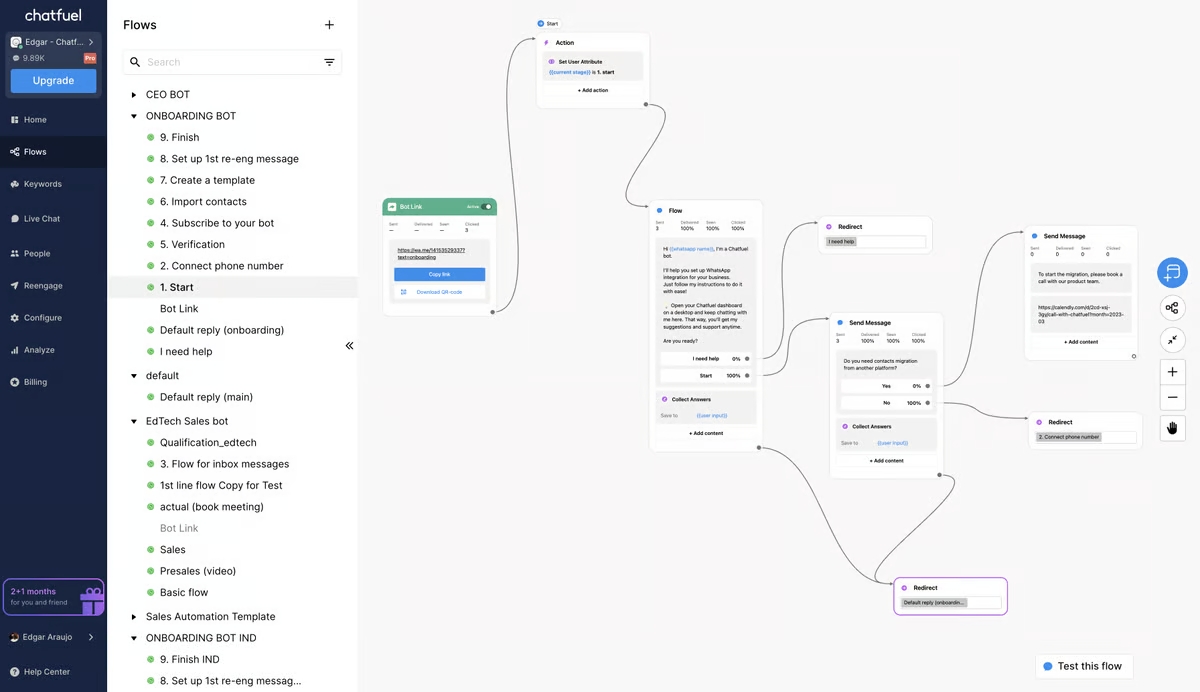
Chatbot best practices: 6 things your business needs
Discover 6 essential chatbot best practices to enhance user engagement and meet business goals. Learn how to optimize your chatbot for success.
Need help to get the most out of your chatbot? Many businesses launch chatbots with high hopes, only to fall short of expectations. Whether it’s a lack of engagement or customer frustration, the root cause often lies in not following chatbot best practices that can make or break your chatbot's success.
Today, you will learn:
How to define the scope and objectives of your chatbot to align with your business goals
Best practices for creating a user-friendly chatbot interface that encourages engagement
Tips for making chatbot interactions more human-like and transparent
Let’s dive into the essential chatbot practices your business needs to follow.
6 Chatbot best practices for a business
Most people believe that implementing chatbots in your business is about deploying the latest technology (because many think it must be the best). However, it’s more about using that technology to align with your business goals and enhance the customer experience.
Without a solid foundation of best practices, even the most sophisticated AI chatbot models can fall short, leading to poor user engagement and unmet objectives.
To avoid these pitfalls, consider partnering with the best chatbot development company to ensure your chatbot is set up for success. Regularly incorporating user feedback is crucial for refining and optimizing your chatbot’s performance.
In the following sections, we’ll walk you through six essential chatbot best practices that can make the difference between a successful chatbot that drives business value and one that simply takes up space on your website.
Let’s explore each of these practices in detail, starting with defining the scope and objectives of your chatbot.
Chatbot best practice number 1: define the scope and objectives
Before you start building your chatbot, clearly defining its scope and objectives is essential. This foundational step ensures that your chatbot serves a specific purpose and meets your business goals effectively. A well-defined scope prevents unnecessary feature additions and keeps the project focused, while clear objectives help measure success and guide continuous improvement.

Source: Pexels
How to define the scope
To define the scope of your chatbot, begin by identifying the specific customer pain points you want it to address. Ask yourself key questions such as:
What are the most common issues my customers face?
Which tasks do I want the chatbot to automate or assist with?
What specific outcomes do I want to achieve, such as increased sales, faster customer support, or improved lead generation through effective customer service chatbots?
Identify the target audience
Understanding your target audience is crucial for shaping the chatbot’s tone, language, and interaction style. Different demographics will have varying preferences and expectations when interacting with a chatbot. To effectively reach a global audience, you may want to create a multilingual chatbot catering to diverse linguistic needs.
Consider the following:
Demographics: Tailor your chatbot’s conversation style to match the age, gender, and cultural background of your audience. For instance, if you’re targeting a younger demographic, integrating your chatbot with platforms like Facebook Messenger can enhance accessibility and engagement
Customer behavior: Analyze how your target customers typically interact with technology and adjust the chatbot’s design accordingly
Preferences: If your audience values quick, straightforward communication, ensure your chatbot reflects that in its interactions
Other factors to consider
When defining the scope and objectives of your chatbot, it’s also important to consider:
Brand voice: Your chatbot should reflect the tone and personality of your brand. Whether your brand is formal and professional or casual and friendly, ensure that the chatbot’s language aligns with your brand identity.
Complexity of tasks: Start with simple tasks that your chatbot can handle effectively, and consider expanding its capabilities as you gather data and feedback.
Integration with existing systems: Ensure your chatbot can integrate seamlessly with your existing CRM, customer support systems, and other tools to provide a smooth user experience.
Chatbot UI best practices
The chatbot UI plays a critical role in how effectively it interacts with users. A well-designed UI makes the chatbot easy to use and improves the overall user experience by smoothly guiding customers through their interactions. Here are chatbot design best practices to ensure your chatbot's UI is both functional and engaging.

Source: Chatfuel
Contextual buttons
Context buttons are one of a chatbot's simplest yet most effective UI elements. They indicate the action a user is about to take. This reduces confusion and enhances the interaction flow, contributing to a more engaging user experience.
For example, instead of using a generic “Yes” or “No” button, opt for more descriptive labels like “Sign me up” or “No, thanks.” This approach helps users quickly understand their options and keeps them more engaged with the chatbot.
Re-engagement options
To maintain the flow of conversation and prevent users from dropping off, it’s important to include re-engagement options. Features like a “Take me back to the start” button can be invaluable when users feel lost or want to reset the conversation. These options help keep the conversation moving and ensure users don’t abandon the interaction out of frustration.
Fewer choices lead to better results
While it might seem logical to offer users a variety of options, studies have shown that limiting choices can actually lead to better engagement. In fact, chatbots that present too many options can overwhelm users, resulting in lower adoption rates.
For instance, Chatfuel’s automation solution helped Nissan achieve remarkable results by simplifying their lead qualification process. Using a Messenger bot to streamline options and guide customers through a more focused decision-making process, Nissan saw a 10x increase in monthly organic sales and a 3.5x boost in qualified leads, generating an additional $380,000 in sales within the first month.
By simplifying the decision-making process, you can help users take the desired actions more often.
Chatbot best practice number 3: bring conversations to life with human-like interactions

Source: Pexels
A key to a successful chatbot is its ability to engage users in natural and human-like conversations. While users understand they’re interacting with a machine, the more lifelike and responsive the chatbot is, the more likely it is to satisfy and retain users.
Leveraging advanced tools like Fuely AI can help create these natural, human-like interactions by improving your chatbot's conversational capabilities.
This section will explore how to design your chatbot to simulate human interactions effectively.
Tips for human-like interactions
To encourage human-like interactions, consider the following:
Natural language processing (NLP): Leverage NLP to help your chatbot understand and respond to user inputs more naturally. The goal is to create a conversational flow that mimics human speech patterns, making interactions smoother and more intuitive
Personalization: Incorporate personalization elements by greeting users by name and tailoring responses based on previous interactions. This makes the conversation feel more personal and relevant to the user, increasing engagement
Transparency: It’s essential to be upfront with users about the fact that they are interacting with a bot. This honesty sets the right expectations and prevents users from feeling deceived. Make sure your chatbot introduces itself as an artificial intelligence agent at the start of the conversation
Escalation to human agents: Even the best chatbots have limitations. Always provide users with the option to speak to a human agent if the chatbot is unable to resolve their issue. This seamless handoff is crucial for maintaining user trust and satisfaction
Use conversational cues: To make interactions feel more human, incorporate conversational cues like “typing” indicators or slight delays between messages. This mimics the natural pauses in human conversation and makes interactions more genuine
Be transparent about limitations
While chatbots can handle many tasks efficiently, they do have limitations. Being transparent about these limitations is crucial to maintaining user trust and satisfaction. Users appreciate honesty and are more likely to have a positive experience if they understand what the chatbot can and cannot do from the get-go.
Steps to address limitations
Here are 4 steps to address your chatbot's limitations:
Step 1: acknowledge when the bot doesn’t have an answer
Instead of providing incorrect or confusing information, the bot should acknowledge its limitations. For example, responses like “I’m not sure about that, but I can connect you with someone who can help” set the right expectations and guide the user to the next step.
Step 2: forwarding to human agents
Ensure your chatbot has a clear and seamless process for escalating conversations to human agents when necessary. This is a crucial feature when choosing a chatbot provider, as it directly impacts user satisfaction.
Handovers can be triggered by specific user requests or when the bot detects it cannot resolve the issue. The transition should be smooth, with the bot passing on any relevant conversation history to the human agent to avoid repetition and save the user’s time.
Step 3: set clear expectations from the start
At the beginning of the interaction, your chatbot should clearly state its capabilities and limitations. For instance, it might inform users that it can handle basic inquiries but will transfer more complex issues to a human representative. This transparency helps manage user expectations and prevents frustration.
Step 4: provide alternative resources
If the chatbot is unable to assist, it should offer alternative resources such as:
Links to relevant FAQs
Help articles
Contact information for human support
This helps users find the information they need and reinforces the bot’s role as a "helpful tool."
Best chatbot practices for customization
Customization is a powerful way to ensure that your chatbot meets your users' needs and aligns seamlessly with your brand. A customized chatbot can provide a more personalized and engaging experience, leading to higher user satisfaction and better outcomes for your business.

Source: G2
Use emojis and rich media
Incorporating emojis and rich media into your chatbot's responses can make interactions more lively and engaging. Emojis, when used appropriately, can convey tone and emotion, helping to make the conversation feel less robotic.
Similarly, using images, GIFs, and videos can enhance the user experience by providing visual context to your responses, especially in industries like e-commerce where showcasing products is essential.
Script grammatically correct responses
Nothing undermines a chatbot’s credibility faster than poorly written responses. Ensure that your chatbot’s scripts are grammatically correct and free of typos. This is particularly important if your brand is positioned as professional or authoritative. A well-written chatbot script helps build trust with users and reflects positively on your brand.
Match the bot’s design with your brand’s look
Your chatbot should embody your brand. This means using the same color schemes, fonts, and visual elements that are consistent with your brand identity.
For businesses looking to enhance their visual consistency and user experience, learning how to make a chatbot for free can be a great starting point. A chatbot that is visually aligned with your website or app reinforces brand recognition and creates a cohesive user experience.
Use the right type of chatbot
Choosing the right type of chatbot is crucial for meeting your business goals and providing the best possible user experience. The two main types of chatbots—rule-based and AI-driven—each has its own strengths and weaknesses. Understanding these differences will help you decide which type fits your business needs best.
Rule-based bots
Pros:
Ease of training: Rule-based bots are relatively easy to set up and train. They follow a predefined set of rules, which makes them straightforward to program and maintain. This simplicity can be beneficial for businesses that need a reliable and predictable chatbot for handling specific tasks
Integration with legacy systems: These bots can easily integrate with existing systems, such as customer relationship management (CRM) tools or databases, to perform specific functions like retrieving user information or processing transactions
Support for multimedia interactions: Rule-based bots can be programmed to handle various media types, such as images and buttons, making them versatile for tasks like customer service or simple lead generation
Cons:
Limited flexibility: Since rule-based bots operate within the confines of their programmed rules, they are less flexible and can struggle with understanding queries outside their predefined scope. This can lead to frustrating user experiences if the bot is unable to adapt to unexpected inputs
Scalability issues: As your business grows and user queries become more complex, rule-based bots may require significant updates or a complete overhaul to meet user needs
AI bots
Pros:
Utilize machine learning: AI-driven bots use machine learning to continiously improve their performance over time. They learn from each interaction, becoming better at understanding and responding to user queries. This makes them ideal for handling complex, dynamic conversations
Handles complex queries: Unlike rule-based bots, AI bots can interpret and respond to a wide range of queries, even if they are not explicitly programmed for each scenario. This makes them more adaptable and capable of delivering a more natural conversational experience
Supports multiple languages: Many AI bots can understand and communicate in multiple languages, making them suitable for businesses with a global audience
Cons:
Complexity and cost: Implementing and maintaining an AI-driven bot can be more complex and costly compared to a rule-based bot. It requires access to large datasets for training and often involves ongoing development to refine the bot’s performance
Potential for errors: While AI bots are highly capable, they can sometimes misinterpret user inputs, leading to incorrect or confusing responses. This is mitigated by continuous training and improvement and is something to be mindful of
Ready to scale your business with a chatbot?
Now that you’ve learned the essential best practices for implementing a successful chatbot, it’s time to take action. A well-designed chatbot can revolutionize how your business interacts with customers, driving engagement, improving customer satisfaction and ultimately boosting your bottom line.
Chatfuel makes it easier than ever to get started with your own chatbot. With no coding required, a user-friendly drag-and-drop interface and a wealth of pre-built templates, Chatfuel empowers you to create a powerful chatbot that aligns with your business needs.
Don’t wait to unlock the potential of AI-powered customer interactions.Start your free trial with Chatfuel today and see how a chatbot can transform your business.
FAQs
What is an FAQ chatbot?
An FAQ chatbot answers frequently asked questions in a conversational style, providing quick, automated responses to common inquiries like product details or service hours. It reduces the workload on customer support by handling routine queries, allowing human agents to focus on more complex issues.
How important is human handover in an FAQ chatbot?
Human handover is crucial when an FAQ chatbot runs into questions it can’t answer. Smoothly passing the conversation to a human agent ensures customers get the support they need for more complex issues.
What are the best practices for designing an effective chatbot?
Effective chatbot design involves setting clear objectives, understanding your audience, and focusing on user-friendly UI/UX. Regular updates based on interactions and user feedback keep the chatbot relevant and effective.
How do I measure the success of my chatbot?
You can measure success by tracking KPIs such as user engagement, resolution rate, customer satisfaction through feedback, and conversion rates for desired actions like lead generation or sales.